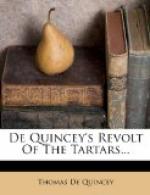30 10. River Jaik. The Ural.
30 33. scenical propriety. Compare the statement with similar ones made by the author elsewhere.
31 11. decrement. Compare with its positive correspondent, increment.
31 20. acharnement. Fury.
31 26. The first stage, etc. A time mark in the essay.
32 10. liable. Another instance of a word often misused, correctly employed in the text. Compare note on aggravate, p. 26, l. 28.
32 23. Bactrian camels. There are two species of camel, the dromedary, single humped, and the Bactrian, with two humps. The former is native to Arabia, the latter to central Asia. The dromedary is the swifter of the two. Bactria is the ancient name of that district now called Balkh, in Afghanistan.
33 7. evasion. Compare with its positive correspondent invasion; compare decrement, p. 31, l. 11.
34 8. champaign savannas. Both words mean about the same, an open, treeless country, nearly level. What is the linguistic source of both words?
37 19. hills of Moulgaldchares. Spurs of the Urals running southwest.
38 10. Polish dragoons. “The adjective refers not to the nationality, but to the equipment of the cavalry. Thus there was at one time in the French army a corps called Chasseurs d’Afrique, and in both the French and that of the Northern troops in our own Civil War a corps of Zouaves. Similarly at p. 53, l. 24, De Quincey speaks of yagers among the Chinese troops. Perhaps both Polish dragoon and yager were well-known military terms in 1837. At any rate there is no gain in scrutinizing them too closely, since the context in both cases seems to be pure invention.”—BALDWIN.
38 11. cuirassiers. From the French. Soldiers protected by a cuirass, or breastplate, and mounted.
38 20. River Igritch. The Irgiz-koom.
39 21. concurrently. Etymology?
39 33. sad solitudes, etc. Notice this as one of the points in a very effective paragraph.
40 3. aggravations. Compare note on p. 26, l. 28.
40 5. howling wilderness. Why so called? Compare with a previous use of the same expression (p. 12, l. 5).
40 18. spectacle. Compare with other references to the theatrical quality of the Flight.
40 21. myriads. Is this literal? Notice the contrast in tone between this sentence and those which close the paragraph.
41 12. adust. “Latin, adustus, burned. Looking as if burned or scorched.”—Century Dictionary.
41 15. erected their speaking eyes. Study this expression until its forcefulness is felt. The camel is notorious for its unresponsive dullness; indeed its general apathy to its surroundings is all that accounts for its apparent docility. De Quincey, therefore, is speaking by the book when he describes these brutes as “without the affections or sensibilities of flesh and blood.” Their very submissiveness is due to their stupidity.




